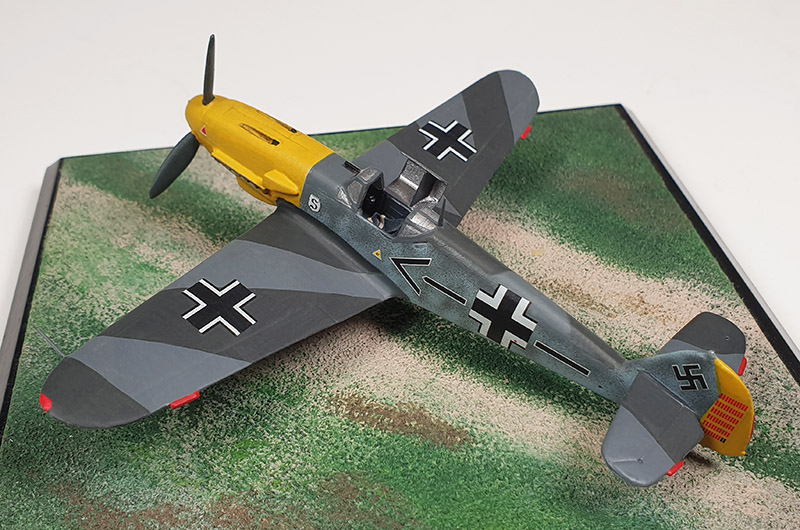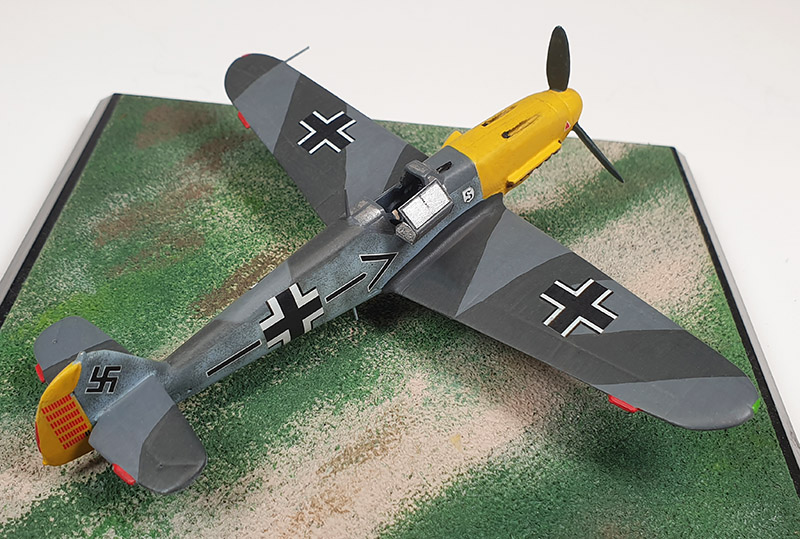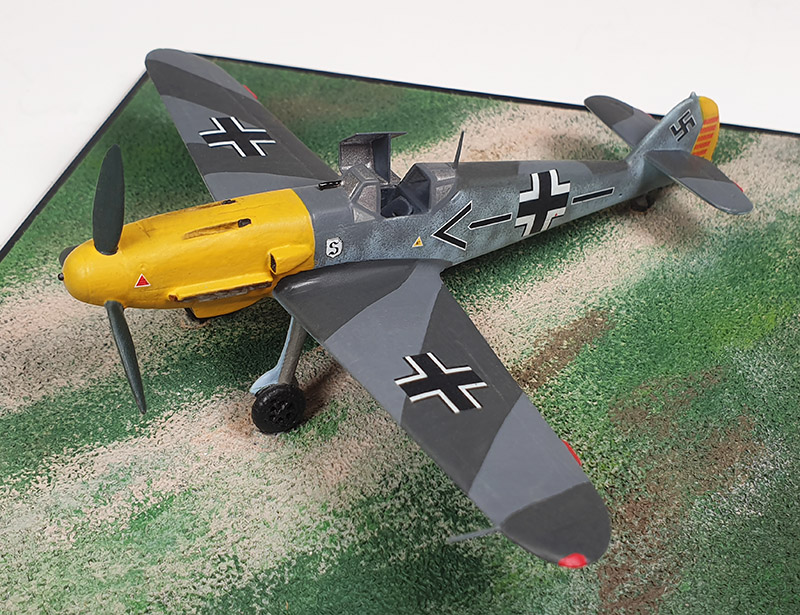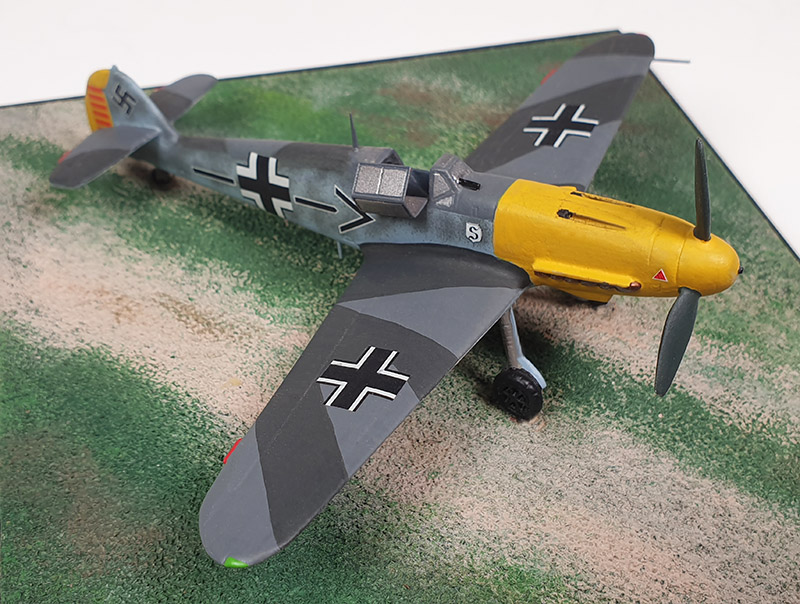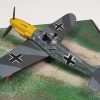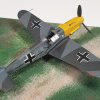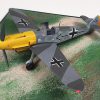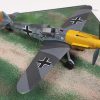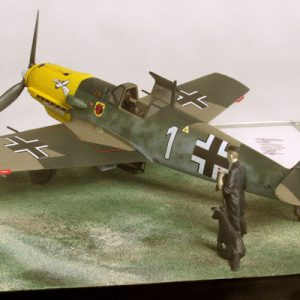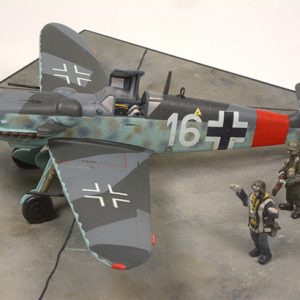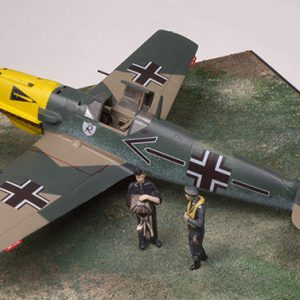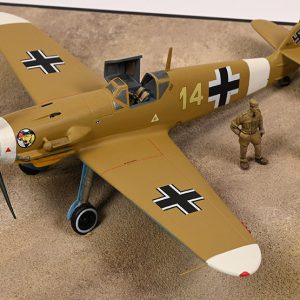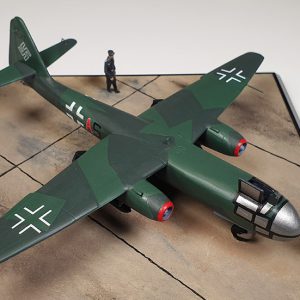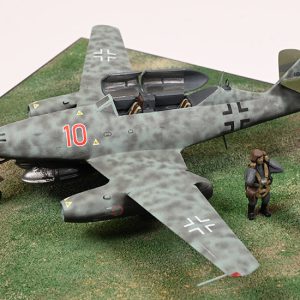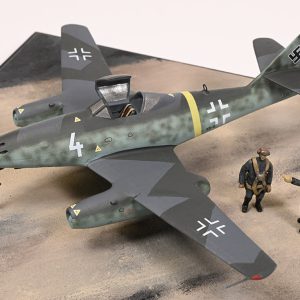Messerschmitt Bf 109F-2 “<-+- ” Wk Nr 6714, JG26 ‘Schlageter’
Geschwaderkommodore Adolph Galland , Brest-Guipavas, April 1941.
The Messerschmitt Bf 109F-2 variant of the Bf 109 introduced a third change in the type’s appearance and was quickly recognisable by comparison with the Bf109E, which had played the major part in the German fighter order of battle from the outbreak of hostilities in 1939; it had rounded wing tips, a redesigned longer cowling to accommodate the more powerful DB 601E engine and with a rounded spinner, and an absence of tail plane bracing struts. The Bf 109F-1 was introduced in to service at the beginning of 1941, and the following Messerschmitt Bf 109F-2 carried an armament of a MG 151 15mm. engine-mounted cannon and a pair of wing-mounted 7.9 mm. MG 17 machine guns; some experienced Bf 109 pilots considered the Bf 109F to be under gunned compared with the Bf 109E, and though under-wing cannon were later added this could have an adverse effect on handling.
Following the Battle of Britain, in which he scored forty victories in his Bf 109E-4/N, Adolf Galland was promoted to Oberstleutnant and given command of Jagdgeschwader 26 “Schlageter”. In early 1941 the fighter defence of Northern France was in the hands of JG26 and Jagdgeschwader 2 “Richthofen” , both re-equipping with the Bf 109F at the beginning of the year. 6714 was the Geschwaderkommodore’s first Friedrich and was fitted with the early square intake to the supercharger (larger and rounded on later Bf 109F aircraft). Galland’s Bf 109F carried the standard “Channel Front” identification colours of a yellow nose and rudder, with the unit’s stylised “S” on a shield. The 58 red “kill” markings on the rudder represent those that Galland achieved on the Emil variant, with two more in black believed to signify those gained with his new mount.
Prior to the completion of painting the chevron and bar markings to the following incident occurred. Jagdfliegerfuhrer Theo Osterkamp a WW I veteran and WWII ace was having his 49th birthday and Galland was preparing to attend the celebrations. What follows is Galland’s own account of the incident known as the ‘Lobster Flight’.
“On 15th April, Osterkamp, the ‘Jafu’ at Le Touquet, was having his birthday. I was invited, so I loaded a big basket with lobsters and the appropriate bottles of champagne into my new 109F and took off with Oblt Westphal as my wingman. On the flight to Le Touquet, the thought of making a slight detour over England was too enticing to resist and soon I spotted a single Spitfire. After a rather wild chase, fate decided in my favour and my enemy who had been very tenacious, finally crashed burning in a small village west of Dover.
Not long after this, we saw a whole squadron of Spitfires climbing with one straggler lagging behind his companions. I approached him quite unseen and from very close range shot him to shreds. By that time we were right into the rest of them. I shot down a third Spitfire which I nearly rammed, but I did not actually see him hit the ground. Nor did Westphal, who got into a good attacking position only to have his guns jam. Now it was time to get out of there, for we really stirred them up. Full power and dive for the Channel! We were being pressed very hard and they were firing at us furiously. Westphal was much faster and I thought something was wrong with my ‘mill’.
As soon as I reached Le Touquet I rocked my wings vigorously, then started my landing approach. Meanwhile, the mechanics below were waving like mad and firing off red signal cartridges to warn me.
Now the penny dropped. I had almost made an unintentional wheels-up landing. When I pushed the undercarriage switch my bird hadn’t put his legs, out but in! I must have been flying with my gear extended. During the dogfight I remembered having bumped the undercarriage switch with my left knee. I also seem to recall that I had to retrim my aircraft because the flying characteristics had changed. You do those sort of things without even thinking. After all that the lobster and champagne bottles were completely unharmed. A fighter pilot has to have some luck and mine was pretty good on that day because not only was I able to give Osterkamp my undamaged present, but a report of Spitfire victories as well.”
Before the end of 1941 Galland was appointed General der Jagdflieger, remaining in France to organise the fighter protection for Operation Donnerkell, the transfer of the battleships Scharnhorst and Gneisenau and the heavy cruiser Prinz Eugen from Brest to German home waters.


